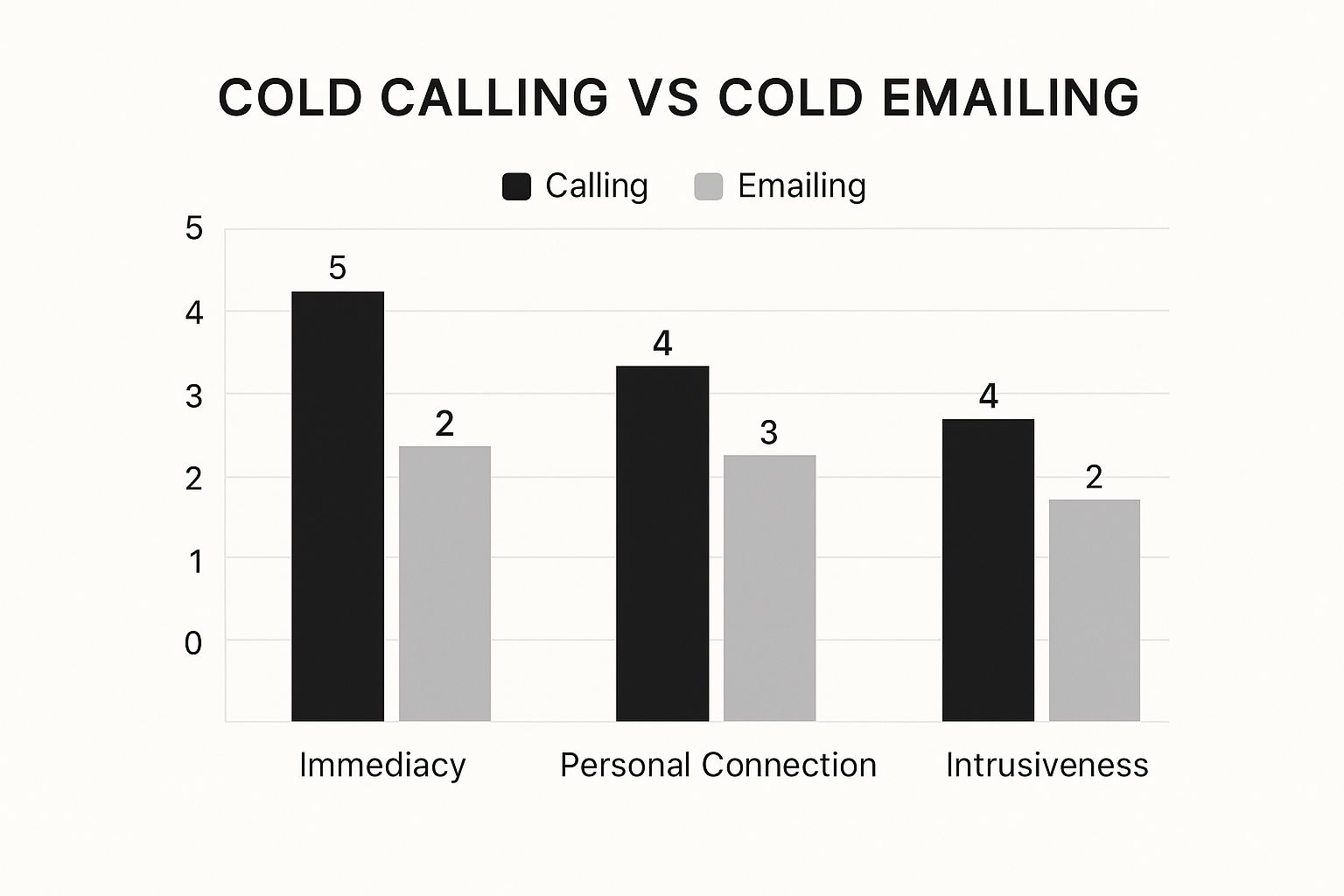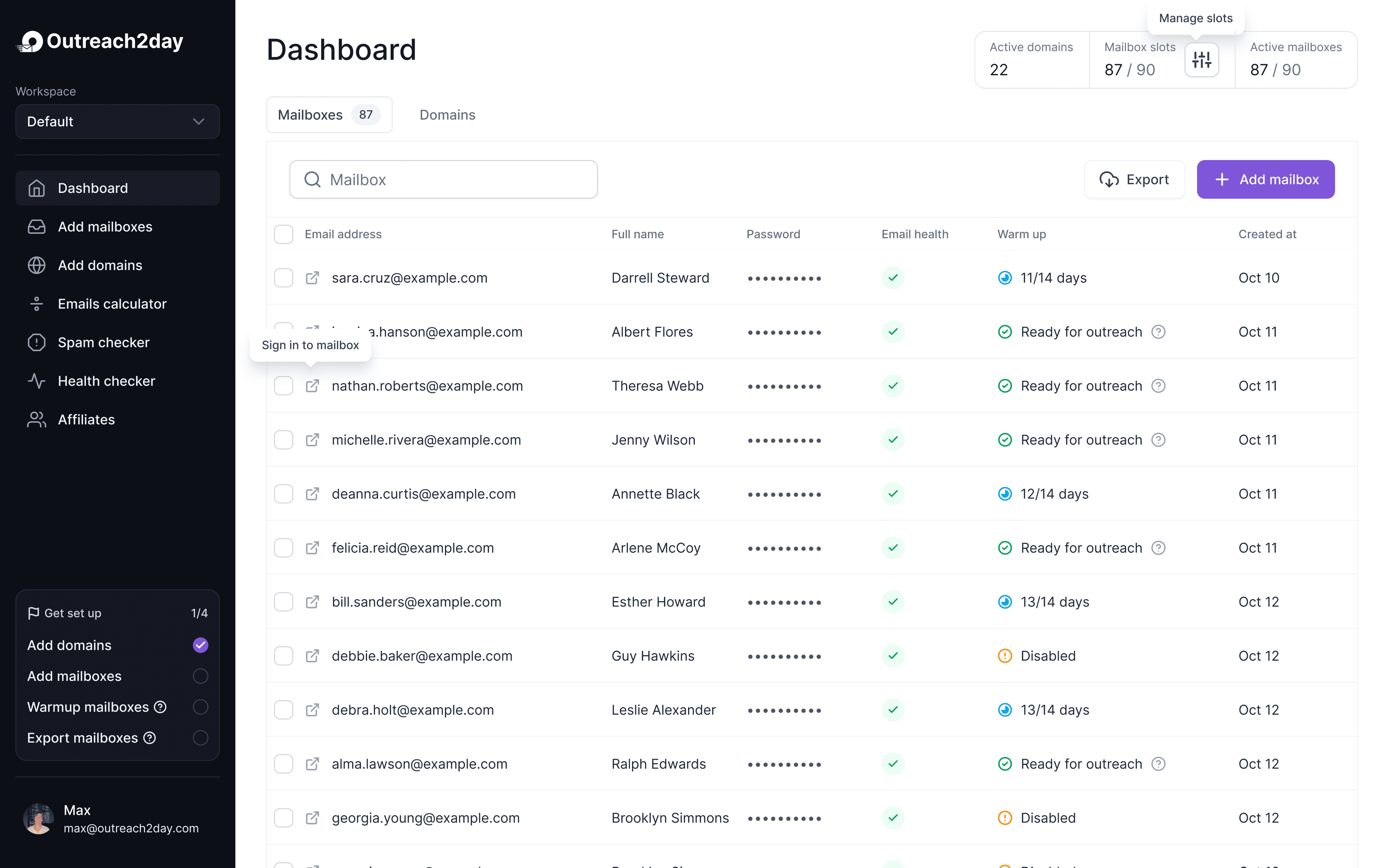Cold Calling vs Cold Emailing Which Strategy Wins?
Oct 12, 2025

When you get down to it, the cold calling vs. cold emailing debate really boils down to immediacy versus scalability. Cold calling gives you that instant, direct human connection—a chance to build real rapport on the spot. Cold emailing, on the other hand, lets you reach a massive audience on their own time, without being too in-your-face.
Which one is right for you? It all depends on whether your sales cycle thrives on personal connection or needs sheer volume to succeed.
Defining the Arena: Cold Calling and Cold Emailing
Cold calling and cold emailing are key components of any outbound sales strategy, yet they operate and are perceived very differently. Understanding these distinctions is crucial for effective outreach.
Cold calling involves contacting a potential customer by phone without prior notice. It's direct, live, and requires immediate attention, aiming to initiate a conversation and gauge interest. However, it can also be seen as a disruptive interruption.
In contrast, cold emailing involves sending unsolicited emails to prospects, allowing them to respond at their convenience. It's less intrusive and highly scalable, enabling one representative to reach numerous leads with minimal effort.
A phone call demands immediate attention, while an email waits for the recipient's convenience. This difference in timing and urgency influences the interaction's dynamics. The decision isn't about which method is superior, but rather which aligns best with your objectives.
Comparing Core Characteristics
This chart breaks down the fundamental differences in how prospects perceive each method, focusing on immediacy, personal connection, and just how intrusive each one feels.

The takeaway is clear: while a phone call is fantastic for creating an immediate, personal touchpoint, it comes at the cost of being much more disruptive to a prospect's day.
A Head-to-Head Comparison of Key Performance Metrics
To address the cold calling vs. cold emailing debate, focus on the data. Outbound sales require measurable results, and these channels differ significantly in response rates, connection rates, and conversions. It's not just about the quantity of replies but their quality and the effort required to obtain them. A data-driven approach clarifies where each method excels and fails, informing your sales strategy.
The Devil's in the Details: Response vs. Connection Rates
Comparing "response rates" across channels can be misleading as they differ significantly. Email metrics focus on open rates and then response rates, while calls emphasize the connect rate, measuring how often a human answers.
For cold emails, the average open rate is about 24%, with a response rate of 8.5%. Despite many emails being ignored, a well-targeted message can capture attention. More details on personalization's impact are discussed in HubSpot's blog.
Cold calling presents a challenge, with an average connect rate of just 5-10%, often hindered by gatekeepers and voicemails.
Although an 8.5% email response rate seems low, it is achieved at scale. Achieving the same volume of live phone conversations requires immense time due to low connect rates.
In essence, email offers scalable, low-effort engagement, whereas calling involves more effort for impactful conversations with a few reachable prospects.
Conversion Rates: The Only Metric That Really Matters
A response is appreciated, but it doesn't cover expenses. The true objective is converting interest into a meeting or sale, where the two methods differ.
With cold emails, conversion is typically slower, with a meeting booking rate of 1% to 5%. This means, out of 100 emails, you might secure one to five meetings—it's about volume.
Cold calling changes the approach. Successfully connecting and handling the call can increase meeting bookings to 10-20% of connected calls, but establishing that connection is challenging. The overall conversion rate per call is closer to 2%.
The core issue is clear: emails may convert fewer individuals but can reach many, whereas calls are more effective if connected, yet few will connect.
Performance Metrics Cold Calling vs Cold Emailing
Let's lay it all out. This table gives you a clear, side-by-side look at the average performance you can expect from each channel. Keep in mind, these are benchmarks—your industry, list quality, and skill will make these numbers swing wildly.
Metric | Cold Calling | Cold Emailing |
|---|---|---|
Initial Engagement Rate | 5-10% Connect Rate | 20-30% Open Rate |
Positive Response Rate | 10-20% of Connections | 1-10% Reply Rate |
Meeting Booking Rate | ~2% of Total Dials | ~1-5% of Total Emails |
Scalability | Low (Time-Intensive) | High (Automation-Friendly) |
Effort per Interaction | High (Manual & Personal) | Low (Template & Automated) |
When you look at the raw data, the conclusion is clear. Cold email is your tool for building a wide, shallow pool of leads with incredible efficiency. Cold calling is your scalpel for deeply engaging a small, highly-qualified group of prospects. The best sales teams don't pick one; they build sequences that leverage the strengths of both.
Analyzing the True Cost and Required Resources
When comparing cold calling and cold emailing, the cost extends beyond software subscriptions. The true expense includes time, personnel, and skills required for effective outreach.
Cold emailing appears less costly, primarily involving expenses for email automation platforms. For specific pricing details, you can refer to our email infrastructure pricing.
Conversely, cold calling demands greater investment in both technology and staff. While a power dialer is necessary, the major cost is the sales development representative, which includes their salary, training, management, and commissions.
The Scalability Equation
The core issue of resource allocation is scalability. Cold email is designed for high volume; one person can send thousands of personalized emails quickly, unlike the limited reach of cold calls.
Cold emailing separates effort from volume, allowing a campaign to be sent to thousands with little extra work. Cold calling, however, requires an equal amount of effort for each contact, consuming significant time and energy.
Email is a highly efficient method to reach many prospects or test messages without needing a large team, as the incremental cost of contacting additional people is negligible. In contrast, increasing cold calls necessitates either more staff or overextending current employees, making it less scalable compared to email campaigns.
Divergent Skill Sets and Human Capital
The necessary skills differ greatly between cold calling and cold emailing, affecting team composition.
Cold Calling Skills:
Resilience: Reps face frequent rejections and must maintain a positive attitude.
Verbal Skills: Quick thinking and objection handling are essential.
Rapport Building: Establishing trust quickly is crucial.
Cold Emailing Skills:
Copywriting: Crafting compelling subject lines and messages is vital.
Analytical Skills: Understanding data trends like open and reply rates is key.
Strategic Planning: Designing effective email sequences is necessary.
Ultimately, the "true cost" encompasses the entire setup, not just software. Cold calling suits charismatic speakers, while cold emailing fits skilled writers and data analysts. The best approach aligns skills with the channel to achieve objectives.
When to Call vs. When to Email: A Strategic Breakdown
Let's set aside metrics and focus on practical implications. The debate between cold calling and cold emailing isn't about superiority; it's about selecting the appropriate tool for the task. An effective outreach strategy is adaptable, changing according to the audience, the product, and the industry. Choosing the right method at the right time can mean the difference between securing a meeting and being ignored.
Tailor Your Channel to Your Target
Choosing the right communication channel depends on your prospect's role and work habits. Here's a streamlined guide:
When to Use Phone Calls:
Reaching Executives: C-level leaders and VPs, buried in emails and shielded by gatekeepers, often prefer direct phone contact, with 57% favoring this approach.
High-Value Deals: For significant deals, personal calls allow for instant rapport and address complex queries effectively.
Complex Products: When your offering requires detailed discussion, phone calls provide the necessary back-and-forth to identify specific needs.
When to Use Emails:
Targeting Technical Roles: Mid-level managers and specialists appreciate detailed emails they can review at their own pace.
Wider Outreach: For initial contact with a large audience, email is efficient for gauging interest and identifying potential leads.
Maintaining Communication: Emails are ideal for follow-ups, sharing resources, and keeping prospects engaged over extended sales cycles.
Key Takeaway: Use phone calls for crucial, intricate sales needing immediate interaction. Opt for emails for broad outreach and when prospects need detailed information first.
Let Your Industry and Product Complexity Be Your Guide
In any industry, the nature of what you sell and its complexity play a significant role. Traditional sectors like manufacturing or finance often value phone calls as a sign of respect, while tech decision-makers prefer concise emails. If your emails aren't effective, consider checking our guide on improving deliverability. Despite cold calling's low success rate, persistence can improve outcomes. The most effective teams use both methods strategically, leveraging emails to initiate contact and calls to finalize deals.
The Power of Integration: A Hybrid Outreach Strategy
The debate between cold calling and cold emailing often misrepresents them as competitors, forcing a choice. However, top sales professionals view them as complementary tools in a multi-channel approach. Rather than choosing one over the other, a hybrid strategy leverages the scale of email with the personal impact of calls. This combination creates diverse touchpoints that enhance familiarity and effectively break through the noise. Modern sales teams succeed by sequencing calls and emails strategically, transforming from interruptions to a consistent, helpful presence.
Building a Cohesive Multi-Channel Sequence
A hybrid strategy involves creating a sequence where each interaction builds upon the previous one, ensuring each touchpoint is intentional and not random.
Here are effective ways to integrate both channels:
The Email Warm-Up: Send a personalized email a day or two before calling. This introduction provides context when you follow up with a call, allowing you to reference the email immediately.
The Voicemail Follow-Up: Voicemails often go unnoticed, but following up with an email titled "Just left you a voicemail" provides details and a response avenue.
The Post-Conversation Recap: After a successful call, send an email summarizing the discussion, sharing resources, and confirming next steps. This reinforces professionalism and progress.
A hybrid approach transforms outreach into a structured dialogue, with emails offering the 'what' and calls providing the 'why now.' This approach ensures continuity if one channel doesn’t connect.
A Sample Hybrid Outreach Sequence
Here's a concise version of the five-day sequence for building familiarity without being too forward, combining automation with personal interaction:
Day 1: Initial Contact
Send a personalized email addressing a specific pain point, introducing yourself as a resource.
Day 2: First Call
Make a cold call.
If answered: Refer to your email, asking if they had a chance to read it.
If voicemail: Leave a brief message, mentioning your email and providing your contact number.
Day 3: Voicemail Follow-Up Email
If voicemail was reached on Day 2, follow up with a short email referencing your previous communication and offering a quick chat.
Day 5: Value-Add and Final Call
Send an email with a useful resource, such as a case study or article, followed by a final call to confirm receipt.
This structured approach balances automation with personal calls, enhancing your chances of a response.
Tools and Automation for Scaling Your Outreach
An effective script or subject line is just the beginning. For real impact, appropriate technology is essential. Manual dialing or emailing won't suffice for growth. Scaling cold calling and emailing requires dedicated tech stacks. The right tools eliminate repetitive tasks, allowing your team to focus on building relationships and closing deals. Without a strong tech foundation, opportunities are missed.
Technology for Cold Calling
To effectively scale cold calling, ensure your representatives maximize their time speaking with potential clients rather than on administrative tasks.
Dialers: Power dialers immediately connect the next call once a representative hangs up, eliminating manual dialing. Predictive dialers dial multiple numbers and connect only when someone answers.
CRM Integration: Dialers must sync with your CRM to log calls, record outcomes, and schedule follow-ups automatically, preventing any leads from slipping through the cracks.
Call Recording & Analytics: Recording and analyzing calls helps with coaching, identifying successful strategies, and ensuring compliance.
The goal of cold calling technology is to increase live conversations by reducing administrative tasks.
Essential Tools for Cold Emailing
Scaling cold email requires smart automation, personalization at scale, and ensuring email delivery without hitting spam. Selecting the appropriate bulk email sender software is essential. Our guide on choosing the best bulk email senders offers key insights.
Consider these components:
Email Automation Platforms: These manage sequences, schedule follow-ups, test subject lines, and track metrics like opens and clicks.
Personalization Engines: Tools that incorporate dynamic snippets, such as a prospect’s name or company, to maintain a personal touch.
Deliverability and Warm-Up Services: These tools gradually build your sending reputation, crucial for avoiding spam filters and reaching the primary inbox.
Got Questions? We've Got Answers
You're not the first to wrestle with the whole cold call vs. cold email thing. It brings up a lot of questions. Here are the straight-up answers to the most common ones we hear.
Is Cold Calling Illegal or Outdated?
Cold calling is legal but regulated. In the U.S., laws like the Telephone Consumer Protection Act (TCPA) govern calls to mobile numbers and auto-dialers. You must check your lists against national Do-Not-Call registries.
Despite some opinions, it's not outdated. In complex B2B sales, direct calls are effective, cutting through digital noise, especially for high-value accounts.
Compliance is essential: respect Do-Not-Call lists and provide easy email opt-outs to protect privacy and your company's reputation.
How Many Follow-Ups Should a Cold Email Sequence Have?
The optimal number of emails is typically 3 to 5. Start with an initial email, followed by key follow-ups. Persistence is important, but be cautious to avoid appearing as spam. A good pattern includes a follow-up after 2-3 days, another after 4-5 days, and a final email about a week later. Each message should offer genuine value.
Which Works Better for B2B vs. B2C Sales?
Cold calling suits B2B well, facilitating effective discussions for high-value services or complex products. Cold email is also useful for initial outreach and maintaining leads. Conversely, for B2C, unsolicited outreach is challenging due to strict regulations and consumer impatience. Inbound marketing and ads are preferable, as cold approaches may damage the brand.
Ready to build a powerful cold email engine without the technical headaches? Outreach Today provides the automated infrastructure you need to launch high-deliverability mailboxes at scale. Start sending smarter emails in minutes by visiting https://outreach2day.com.
Setup your outreach in
3 minutes. Literally.
Add or transfer domains from other platforms, set up mailboxes, and initiate warming or export processes

